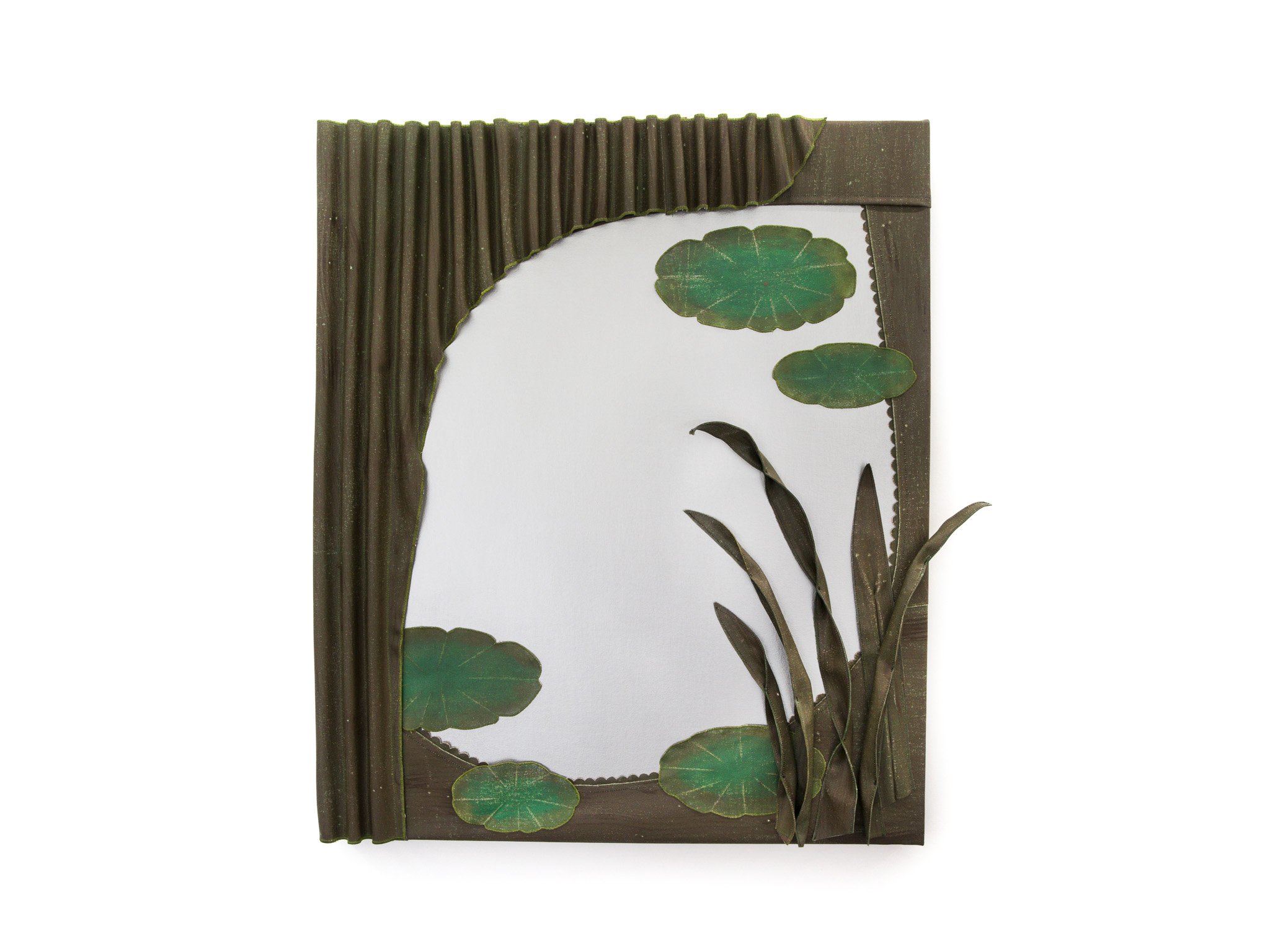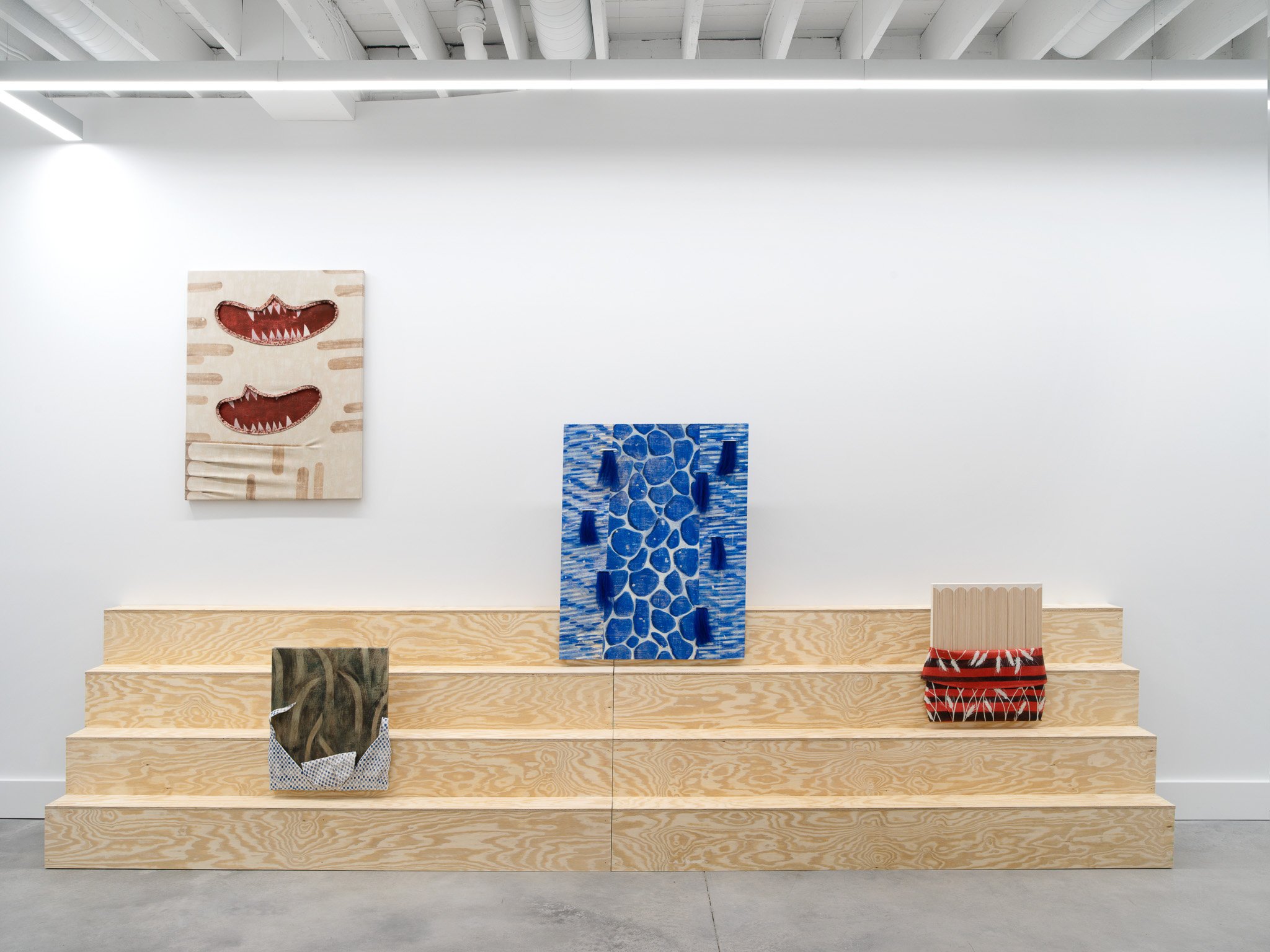Puffy at Most: A Conversation with Susan Metrican
Oakland-based artist Stephanie Rohlfs interviews Susan Metrican on the occasion of her exhibition Married to the Ground at Rivalry Projects, which ran July 22 through September 2, 2022.
Susan Metrican, Where Have You Been, 2021. Acrylic on canvas and thread. Courtesy: Rivalry Projects and Susan Metrican. Photo: Ryan Arthurs.
Stephanie Rohlfs: I’m excited to talk with you because I loved your work in Married to the Ground at Rivalry Projects so much. Ryan [Arthurs] gave me a walkthrough and shared some background, and it was so interesting. So, when I saw the Cornelia call, I was like, "What a great excuse to talk to Susan!" I know elsewhere you’ve talked about making objects feel culturally familiar. Could you speak to that?
Susan Metrican: The things that visually inspire me are old textiles and objects that hold a cultural relevance in, say, Japan, Thailand, or Korea, where there's a shared understanding of how to use the objects and their meanings. If the object represents some type of animal or a scene, most people who engage with it know the history or the story, or they have some shared knowledge about what it is. Since my process involves shaping these materials into imagery, sometimes they can be a bit abstract. I've talked with people who might look at one of them and not see something figurative or representational in it at all, and I like that wiggly sort of space. So, I guess if you recognize tiger paws or a snake, that's kind of operating like a universal language between us even if we wouldn't all know the Vietnamese folktale that's referenced. Animals are something with which we can connect and identify. I don't know — maybe I started thinking more about animals after becoming a parent? [laughs] All of those animal books must play a role.
Stephanie: Is there a desired reading? Or are you interested in the multiplicity that's available based on whatever the viewer comes in with?
Susan Metrican: Married to the Ground, 2022, installation view, Rivalry Projects, Buffalo, NY. Photo: Ryan Arthurs.
Susan: There's no specific desired reading. But I like talking to people about the formal stuff: the way the image only comes to the surface at the very last moment. There are physical manipulations I'm doing — which are not extensive but there are a few things I'm doing — and that's one of the languages through which I like to connect with people. I think of my work in terms of little genres. There are the animals, plants, and insects, and then there are scenes like paths and things like that. There are moon paintings. I also think of them in terms of how they're put together. A Hole is a Home (Komodo) (2020) has paws and Komodo dragon heads, and it's put together like a weaving. There are a few works where I've used the same structure, so in my mind they resonate with each other.
Stephanie: I want to ask about the zoomorphism in your work.
Susan: I lived in Bangkok for a couple of years after undergrad, and it happens frequently in Thai architecture. There's a temple called Wat Samphran, the Dragon Temple. I feel like those snaky paintings are very similar in the way they’re put together. It's really over the top. There's also the Elephant Building. That was always just like . . . what? [laughs] That structure is so funny and good. It keeps its rectangular structure, and it’s kind of hard even to see that it’s an elephant. The rectangular part of the paintings — sometimes they're insects or creatures that I'm creating — always have to kind of adhere to that rigid shape. But this is a good example of that, I think. It's so silly but playful and fun and weird — there's even a tail. I like quoting those things.
Stephanie: It was interesting to me that you did these over a period of years because it felt like a really cohesive, "I'm going to make this show" kind of a show. It felt really consistent to me in terms of the visual textures and the kind of worn-in color palette.
Susan: Color is one thing that really guides them. As I'm looking at the various visual resources that I'm into, sometimes color schemes will just start ringing bells. Sometimes a jumping off point for me is the color.
Stephanie: Do you catalog colors when you come across them and return to them later? It's an impossible question, but how do you start a piece?
Susan: I actually use Pinterest a lot. I'd say that my practice does extend to lying in bed and just thinking about things, seeing color relationships when I close my eyes . . . . But yes, I'm collecting tons of imagery and color schemes and things that I want to revisit.
Susan Metrican: Married to the Ground, 2022, installation view, Rivalry Projects, Buffalo, NY. Photo: Ryan Arthurs.
Stephanie: Speaking of the bed being a studio, a lot of the work in this show was made during the global nightmare that we've all been living through in which we never left the house. As a mother especially, I'm sure that was intensified.
Susan: Well, because we were in Iowa, I felt very fortunate to have space and access to natural spaces, so I didn't feel that isolation as much. We separated ourselves in the way that other people did, but in terms of how it influenced the work, I think it changed what I was looking at. I was thinking about our house and about furniture and fixtures. We have some green space in the backyard, and watching things bloom that first spring was pretty intense. And because I sand my work after I paint it, I would just drag it out to the backyard to do that. With Look Up (2021) I just dragged it under the apple tree and traced the shadows there. And I think that the past couple of years made it feel more natural to include my own lived experience, like what happens on a walk when you see weeds and grasses flowing or their shadows. Those little, tiny visual moments that sort of already look like they are finished works.
Stephanie: I've spoken to a couple of people who felt a shift recently between trying to make work about the thing that they make work about, and then kind of welcoming their life into it a little bit. More of a blended environment like you're talking about; your apple tree, the shadows, working from home . . .
Susan: Yeah. I mean, I feel that I was headed this way. Maybe things just became a little bit clearer over the past few years. We're also just settling into living here. We've been here for four years — we were in Boston before this — and I was hoping that having more access to nature would change the work a bit. So it feels natural that it's kind of happened that way.
Stephanie: There is a piece that references wildfires, Smoking Late June (2021), which being a West-Coaster, obviously I feel like I had to spend some time with. I think you described it as being diapered? And you made a connection to diapering your own child, but a painting itself being diapered, I think, is such an interesting thing. And I saw something similar in Wealth & Prosperity (by Night) (2019) from your Neighbor Bridge Neighbor show at Maharishi International University.
Susan: It’s sort of like a burlap sack with some acorns. And Working Day (2021) also has this kind of sack. Sometimes the paintings are like weavings, sometimes they have little sacks or pants. That's another one of the things that I revisit, but sometimes the work just gets nicknamed. Like, they're just kind of "the one with a diaper," you know? I didn't go into this piece thinking about all of those things. I remember just responding to some iris leaves from the garden and looking at checkered lilies and the work of photographer Karl Blossfeldt. But then when I have to talk about the synthesis of all those things, I'm like, “How do I put this together?”
Stephanie: I was wondering if you saw the diaper as an obscuring tool? Or maybe one for protecting or hiding? What does that feel like to you?
Susan: I think they're kind of containers. Actually, this comes from something further back. If Given the Stage (2017) was the first painting with that same kind of form. I think of it as a frog, with thighs and little feet, and there are little slits where the canvas folds over the stretcher. I think Philosopher's Frog (2018) and Year of the Pig (2019) came out of that kind of squatting gesture. So, they're pants, a container . . . . It has turned more into a container. It was sort of like thighs before, and sometimes there's a belt. In Wealth & Prosperity (by Night), it's quoting a Japanese netsuke. Netsuke are little ornaments attached to a small case worn on the sash of a kimono, and I kept seeing different versions of a rat or a mouse with a sack of nuts and I responded to that. In some ways, I have a desire — or the work has a desire — to be in dialogue with those objects, and an aspiration to be shared or understood or lived with. Or put to use, if it's a functional object. When I take myself down that road of thinking about the work and how it might function, I do sometimes think about them as being discovered. I like imagining that they have been found after a long time or have been passed down or inherited. I physically sand them with a sander, and sometimes there are holes. Power Swimmers (path) (2020) has a lot of holes in it because there were screws on the wall behind the canvas, and that just reminds me of old theater backdrops. I think about how those are repurposed for different scenes, and they have this quality of being kicked around, rolled up and put away, and reused again for another production.
Stephanie: Is that something that you ever do? Do you make something for one painting, but it doesn't feel right and then you save it for later?
Susan: Yeah, it has happened. Not a lot but yeah, sometimes. I mean, sometimes I just use the canvas over and paint over it. But it wouldn't necessarily be exactly saving it for later.
Susan Metrican: Married to the Ground, 2022, installation view, Rivalry Projects, Buffalo, NY. Photo: Ryan Arthurs.
Stephanie: So basically, a polite no. [laughs]
Susan: A polite no. I entertained it, but no, the answer is no. [laughs] But I guess I'm just kind of working on developing a language. Right now, I am very intrigued and intimidated by design: furniture design and the applied arts. In my talk at Rivalry, I talked about William Morris and the Arts and Crafts movement, and that philosophy of returning to the handmade. And that led me to looking at other communities of artists or designers or makers creating in tandem as workshops. Omega Workshops is another one that's interesting. The first World War kind of made it obsolete, but they were basically painting furniture, designing textiles, and decorating clients’ homes. Again, I think that was like the furniture thing: just really looking at objects in a different way after being home.
Stephanie: You've mentioned furniture and industrial design and those sorts of things a few times. Do you have any interest in making objects that function? I don't want to imply that art isn't a function, but do you want to make, like, a chair?
Susan: I do. Yes, I do. I think the stairway from Married to the Ground [at Rivalry Projects] was my gateway into that, and I'm starting to kind of test out painting with dye. I'm still working on getting what I want out of it and trying to figure out what it does, but that kind of lends itself to my interest in textiles and that kind of thing. But I find that if I start from painting patterns, it can be a little bit of a dead end for me. So, I think it would be more interesting to portray a patterned chair than just to have the pattern. It has to perform. The pattern has to perform as a path or something that serves the overall picture.
Stephanie: You mentioned the love of play in the studio, and I can't think of anything less playful than patterns. Patterns are so rigid. But there's something sort of similar in the way that a pattern might fold around a chair and the way your canvases might fold into a frog. I feel like there's a kinship there.
Susan: It's a bit intimidating to think about it at the moment, but I am thinking about library ladders and chairs. And I just discovered Josef Frank. I worked in the dye room of a clothing store before I got hired at Maharishi International University, and the owner had this incredible Josef Frank sofa. He was an architect and a textile designer from Vienna who immigrated to Sweden in the 30s. Just looking at that chunky form and where the wood enters in and the legs, the furniture . . . . It just seems like it opens up something else for me. But I don't have the skills to do that at this point.
Stephanie: Is it important to you that you make everything by hand, or are you someone who would be open to working with fabricators?
Susan: I haven't had the opportunity, but I would be. Not to paint, but certainly the fabrication part.
Stephanie: I'm just curious because you mentioned a love of handcrafting.
Susan: Yeah, but the issue is that I have no skill! [laughs] I don't know . . . . I don't think of my work as sculpture because I don't have a sculpture skill set. They are puffy at most. They were created with a flat mindset, which is where I'm coming from.
Susan Metrican: Married to the Ground, 2022, installation view, Rivalry Projects, Buffalo, NY. Photo: Ryan Arthurs.
Stephanie: So, what do you think is next for you? I've been imagining objects that I want to see you make, but what are you actively working on?
Susan: Well, I'm trying to figure out what painting with dye will do. I just came back from a Shandaken: Storm King residency, and I spent a couple of weeks working on that, just trying to get the workflow. You have to create an activated dye paste that's got seaweed and some other things that you mix together. So, you have a limited amount of time, which I like. But I don't know, I think that's what I'm doing. And I really have been thinking a lot about furniture, so it's funny that you picked up on that. When I look at that Josef Frank sofa, I'm just like [groans]. The cushions were like a literal soft entry into this realm. And I want them to be used; we sit on them all the time.
Stephanie: I was going to ask about that! I know that you force things to fade through sanding before you show them, but do you want them to continue to fade or are you interested in preserving the state you assign them?
Susan: It's cool when art lives in its environment. I remember when we saw the Niki de Saint Phalle show at MoMA PS1, there were a few wall pieces that had moving parts. They were mostly painted wood, and you could see that they were kind of scuffed up. I got excited about that because it makes it feel real in a way that I really like; the way that pedestals get their corners knocked in and furniture gets scuffed when you live with it. It also has to do with unearthing treasures that we want to take a look at again. I always think of earlier feminist art as having that kind of patina. Like, it's just now getting attention; the artist is in her 80s and they dig out the work and it's kind of scuffed up. I don't know, I like it.
Susan Metrican is an artist living and working in Fairfield, Iowa, following stints in Boston, New York, Toronto, and Bangkok. Metrican received an MFA from the Massachusetts College of Art and Design, her BFA from the Kansas City Art Institute, and attended Skowhegan School of Painting and Sculpture in 2014.
by Stephanie Rohlfs
Stephanie Rohlfs is an Oakland-based mixed-media artist, and a former co-director of City Limits Gallery and The Stipend. Her work, which explores animal enrichment, product design, and the life of things, especially functional objects, has been shown in Bay Area galleries as well as in Buffalo at Hallwalls Contemporary Arts Center and The Buffalo Institute for Contemporary Art. She is currently working on a body of work that playfully engages with doomsday preppers and wellness culture.






